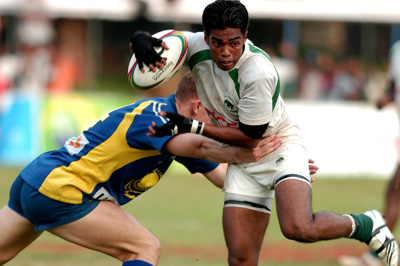
Tactical know-how, technical expertise and organization
I talked to you last week about the many scoring opportunities that originate from the lineout situation. I told you of the need and importance of this area. To get our game better and to make it more enjoyable another crucial area in the game of rugby is the tackle zone. More zip in this area is required as the ensuing play is rather important. There is a huge amount of play in the locality of the tackle ruck and maul. There are over 100 tackles, rucks and mauls in an average game of rugby. At most times it is closer to or over 150. This means that a ruck, maul and tackle takes place almost every 30 to forty five seconds. Apply this to an average playing time of around 30 minute and you may have a tackle, ruck or maul happening almost every 15 to 25 seconds. This is an area where lot of hard work has to be done. If this is not done, the result will be a lot of mistakes. This might well mean that mistakes happen. In which case you might as well have your backs sizing up the spectators and commenting on the silk they wear while waiting hopefully that the ball will be given out their way.
Think back to some games your favourite team lost when you should have won. Have you ever thought of why and what were the reasons for the result. Could it be bad play in the TRM area? Compare with the six nations or the super fourteens. You should because we love to compare often the unlike. Check whether games were lost because you rucked, mauled and played a poor game. Was this the result of bad play in the post tackle situation? But then you don’t think it that way as more often than not you have somebody to blame. Probably it will be the referee. If we are to improve the game these are areas that we should be better so that it could be a winning team. That winning team will then contribute more to the national level. What happens to all the possession and territory you have that is very often squandered by disorganized players in the TRM zone. This includes players in the wrong positions or roles. If you think this is the end of the litany of woes then you are optimistic. Worse to follow are the players who make poor decisions. This is followed by the number of penalties given away by ill-disciplined players arriving illegally at the tackle, ruck and maul. Or that they are keeping their "hands on" the ball supported by others joining from offside positions as well as going over the top. How many times have there been turnover of good ball at the contact because players weren't able to ruck quickly or forcefully, or because support players adopted ineffectual body positions or that simply they were not there. There are many times that try scoring opportunities are lost through slow ball, or players failing to exploit the options at the ruck, or being outsmarted through the phases. These are just a few of the many problems that rugby coaches undergo in most parts of the rugby world. Probably this will not be what you hear from management or the ardent supporters of clubs as well as schools in Sri Lanka. Simply there’s more to rucking than just big hits. The tactical know-how, technical expertise and organization are more important than basic aggression and strength. The focus has to be on individual player skills which contribute to the team effort. There has to be in place methods to stop slow ball killing your game. This involves coaching players to avoid blind contact but to make effective contact. They have to be taught to offload in contact. You have to make the ball carrier work harder in contact, getting support players to arrive better and not necessarily quicker to drive through the ruck and maul. Core tackle, ruck, maul zone skills has to consider rapid clearing out opposition players and securing quality quick ball for the scrum half and more important going forward. It is also important for players to communicate under pressure and to exploit the attacking opportunities. Often a good move or an organized defense go to pieces due to lack of communication. The techniques and tactics should be to get good ball for attack and dynamically clear out the opposition whilst focusing at all times on the ball. Simple strategies must be adopted to improve your ruck maul attack and defense, Decisions have to be made on the number of players who will contest and commit to each ruck and maul. How best your players decide whether to attack the blind side or open side and then how to set up these opportunities for a successful outcome. It is not easy with so many areas to concentrate work and perfect this zone right. The better teams have done so. That is why they are better. You cannot leave all these to be perfected at the club or national level it has to be done before, that is at the school. Vimal Perera is a former Rugby Referee, coach and Accredited Referees Evaluator IRB |
|
||||||
|| Front
Page | News | Editorial | Columns | Sports | Plus | Financial
Times | International | Mirror | TV
Times | Funday
Times || |
| |
Reproduction of articles permitted when used without any alterations to contents and a link to the source page.
|
© Copyright
2008 | Wijeya
Newspapers Ltd.Colombo. Sri Lanka. All Rights Reserved. |

